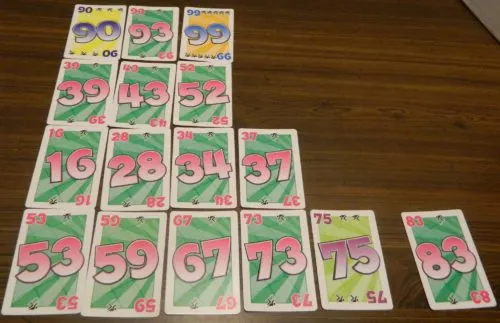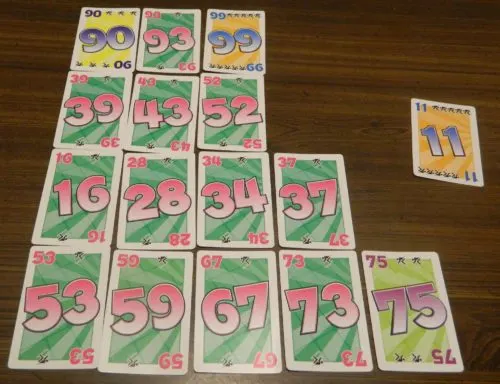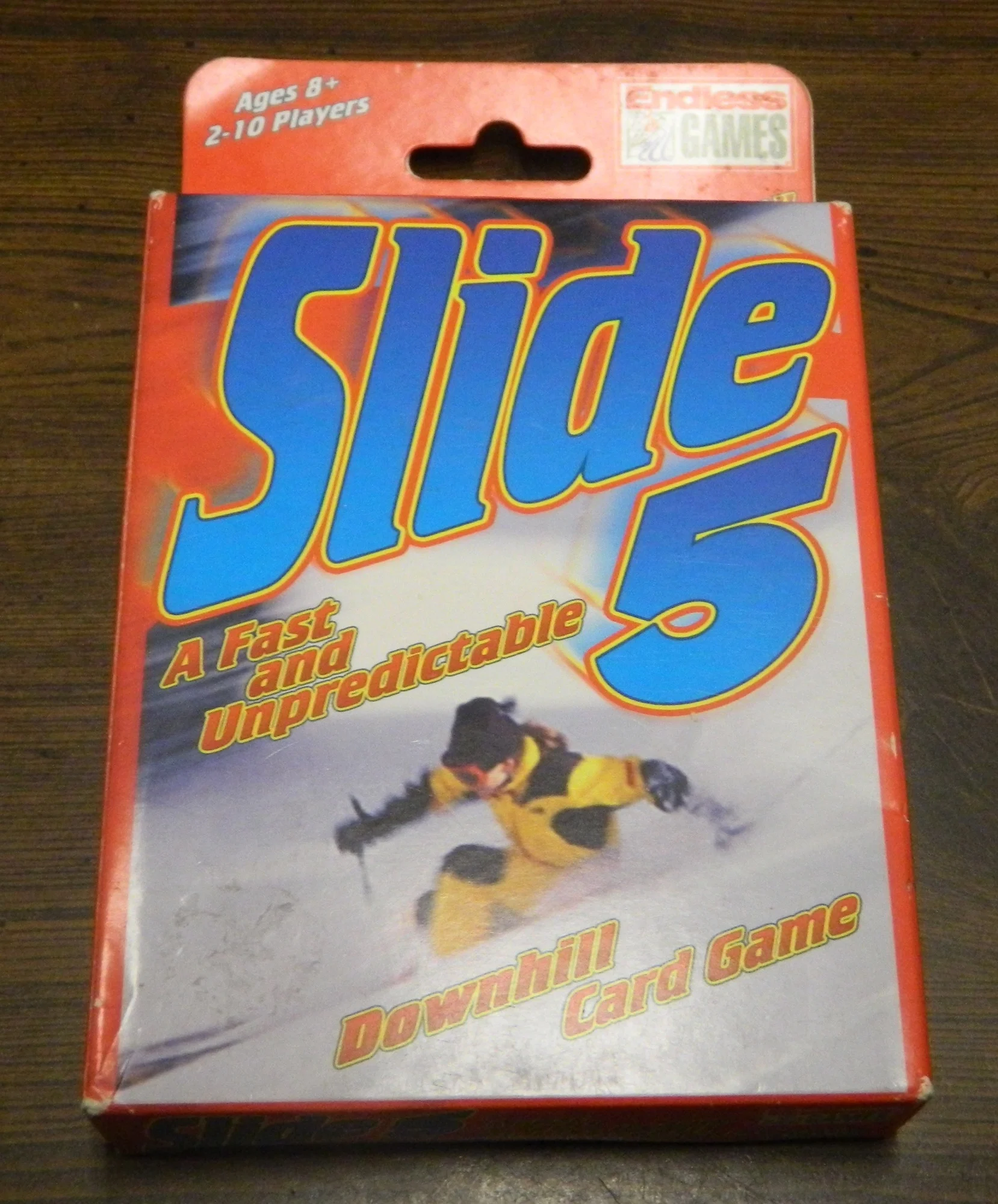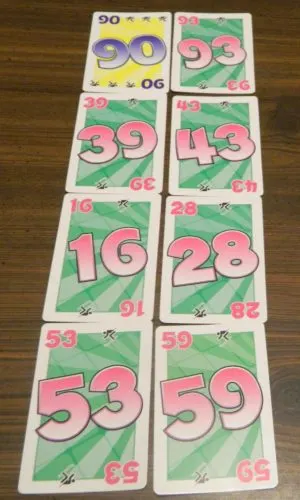How to Play
Setup
Shuffle the cards and deal ten cards to each player. Take the top four cards from the remaining cards and turn them face up forming four rows. The rest of the cards are put aside for the next hand.
Playing the Game
Each game of Slide 5 consists of five hands which consists of ten rounds. To begin a round each player chooses one of their cards and places it face down. All of the player then reveal the card they chose at the same time. The player who played the lowest cards will place their card first in one of the rows followed by the second lowest and so on. The hand continues until all of the players have played all of their cards.
To determine which row a card should be placed in two rules must be followed:
- A card can only be placed in a row where the card is higher than the farthest right card in that row.
- When a card can be played in multiple rows based on the first rule, the row is chosen by the lowest difference between the last card in the row and the card that was played.
Whenever a player adds a card to a row that already has five cards in it, the player must take all of those cards into their score pile. The card they played starts a new row that replaces the cards that the player took.

A player played a 83 card. Based on the placement rules the 83 would be played to the bottom row. Since there are already five cards in that row, the player who played the 83 card would take all five cards from that row. The 83 card would then be the only card left in that row.
If a player plays a card that is lower than the last card played in each row, the player will be forced to take one of the rows into their score pile when it becomes their turn to play their card. The player can choose any of the rows to take and replaces that row with the card that they played.

The player who played the 11 card played a card lower than all of the cards on the right side of each row. This player would be forced to take one of the rows. They would probably want to take the second row since it is worth the least amount of points.
End of Game
When the players have played all of their cards the hand ends. Players then count up their score. Players score one point for every skier symbol on the cards in their score pile.

There are thirteen skiers on this player’s cards so the player would score thirteen points for this hand.
A total of five hands are played. The player with the lowest score after all five hands wins the game.
Review
When I first saw Slide 5 I didn’t give the game a lot of thought. Skiing is an interesting theme for a card game but the game looked like a pretty generic card game. When I saw that the game was created by Wolfgang Kramer though I instantly got quite a bit more interested in the game. For those of you who are not familiar with Wolfgang Kramer, he holds the distinction of winning the most Spiel Des Jahres (Game of the Year) awards with five. While Slide 5 is not Wolfgang Kramer’s best game, it is still a very solid filler card game.
Slide 5 is basically the perfect filler game. The game is quick to play, easy to learn, and can last for as long as you want. The game takes at most five minutes to learn since all you have to learn is how cards are added to the different rows. While the instructions recommend playing five hands, you can play as many hands as you want. If you don’t have a lot of time play less than five hands. If you have more time you can easily play more hands.
For those of you familiar with 6 Nimmt! and Category 5, Slide 5 may sound really familiar. That is to be expected since Slide 5, 6 Nimmt! and Category 5 are all essentially the same game. The games were designed by Wolfgang Kramer and basically all have the same rules. There are only two real differences between the three games. The most obvious is the theme which really doesn’t impact gameplay. The other gameplay element that changes between the games is the end game. In Slide 5 you play five hands while in 6 Nimmt! you play until a player gets 66 points and in Category 5 you play until a player has 75 points. This is a pretty minor difference and since all of the games have the same cards so you could just use the games interchangeably and choose which end game condition you would like to use. Since they are essentially the same game, if you already own 6 Nimmt! or Category 5 there really is no reason to buy Slide 5.
One of the most interesting things about Slide 5 is that it relies quite a bit on card draw luck but with smart plays you can actually turn a bad card into an opportunity to mess with the other players. If you are truly dealt a terrible hand (lots of low cards) you probably won’t score the least points in a hand but you can mitigate the damage more than you would think. If you are going to be forced to take cards at some point in the round you may want to consider playing a low card and taking a row that isn’t worth a lot of points. You can use the same strategy to mess with other players. You could choose to take a row that messes with where another player will have to play their card which might force them to take cards that they otherwise wouldn’t have had to. Luck is still quite important in the game but I like that with clever use of your cards you can mitigate the points you acquire in a given hand.
I think the key to Slide 5 is being able to predict what types of cards that other players are going to play. Having high cards is generally better than having low cards but you need to figure out the best time to play each card. This is why you need to do a good job predicting what the other players are going to do on their turns. If a row is getting near five cards or is already at five cards you either have to avoid playing a card that would be added to that row or you need to play a low enough card that your card will be added to the row before another player is able to add their card. There is a decent amount of strategy in deciding which cards to play by predicting what types of cards the other players are going to play.
The biggest problem that I actually had with Slide 5 came from the errors in the rulebook. If you actually follow the rules presented in the rulebook, the game kind of sucks. Basically the rulebook says that you are supposed to play five rounds and each round entails playing one card. This makes for a very short and terrible game. There is little time for strategy and one or two players generally end up receiving all of the points in the game. My assumption is that when the rules were written the words rounds and hands were mixed up. Since Nimmt 6! and Category 5 are played with multiple hands I am guessing that was the intended rules for Slide 5.
For the first couple of hands I actually followed the broken rules featured in the instructions. While the game is not very fun using these rules they lead my group to coming up with some interesting house rules that I might implement with the game’s actual rules. One rule we came up with was to deal fifteen cards to each player with each player having to play ten of the cards. I like this rule since players still have to play ten cards but they have a couple cards that they don’t have to play. I like this rule since it somewhat negates some of the card draw luck since you have a couple cards that you didn’t have to play.
As far as component quality, Slide 5 is decent but could have been better. The cards feel a little thin. The artwork is quite bland for the most part. The biggest problem with the components are the numbers themselves. For some reason the game choose to have no way of distinguishing between sixes and nines. For a lot of cards the only easy way to tell if it is a six or a nine is to look at the back of the card to see if the card is face up. The game could have easily added a line to the sixes or nines which would have made it much easier to tell between the two numbers.
Final Verdict
Overall I think Slide 5 is a fun little filler card game. The game is not perfect as the game relies quite a bit on card draw luck and there are some issues with the rules. The game is fun though because it is easy and quick enough to play and yet there is some strategy to the game as you need to try and figure out what cards the other players are going to play. Slide 5 is not the type of game that I would play regularly but I plan to bring it out every so often. If you hate filler card games or already own 6 Nimmt! or Category 5 I wouldn’t recommend Slide 5. If you like light filler card games though I would suggest picking up Slide 5, 6 Nimmt! or Category 5.
If you would like to purchase Slide 5 you can purchase it on Amazon. Slide 5, Slide 5 Tin
, 6 Nimmt!



